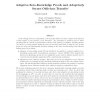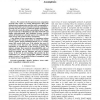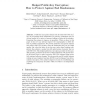21 search results - page 4 / 5 » Adaptive Trapdoor Functions and Chosen-Ciphertext Security |
IACR
2011
12 years 4 months ago
2011
In this paper we present the first public key encryption scheme that is structure preserving, i.e., our encryption scheme uses only algebraic operations. In particular it does not...
TCC
2009
Springer
14 years 5 months ago
2009
Springer
In the setting of secure computation, a set of parties wish to securely compute some function of their inputs, in the presence of an adversary. The adversary in question may be st...
CRYPTO
2001
Springer
13 years 9 months ago
2001
Springer
Recently Victor Shoup noted that there is a gap in the widely-believed security result of OAEP against adaptive chosen-ciphertext attacks. Moreover, he showed that, presumably, OA...
FOCS
2010
IEEE
13 years 3 months ago
2010
IEEE
We construct the first general secure computation protocols that require no trusted infrastructure other than authenticated communication, and that satisfy a meaningful notion of s...
ASIACRYPT
2009
Springer
13 years 8 months ago
2009
Springer
Abstract. Public-key encryption schemes rely for their IND-CPA security on per-message fresh randomness. In practice, randomness may be of poor quality for a variety of reasons, le...



